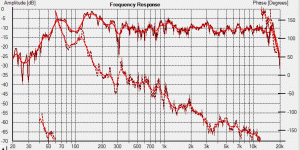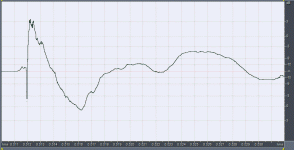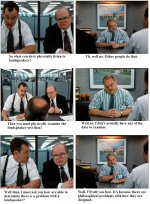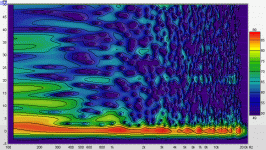Of course. No one is allowed to listen to speakers and make any sort of assessment. Do they sound Good? Bad? Normal? Novel? Please do not report what you hear, it is rubbish.
What is even worse to me is people making an assessment without having heard the speaker in question and discounting the comments of those who have heard them. 🙄
OK, here the promised plots for the SH50, frequency response (incl. phase) and step response, using the "1m livingroom" file that Tom provided.
To me, after adjusting the phase reference to give a quite flat picture in a lin. frequency plot (no overall slope of a dead time), it looks even better than the original plot, only about 180 shift from the XO alone, the range below 200Hz is dominated by the bass rolloff.
One trace is the unsmoothed raw response while the other has a frequency dependant windowing applied, with a 1/4.5 octave smoothing. This gives a cleaned up trace with still enough detail (1/3 is too much smoothing).
The step response (1msec/div) is correspondingly nice, only the very HF is "inverted". Also not the initial rise of the woofers which is modified after ~3ms by the other drivers "kicking in the right way" to keep the response close to zero upt to the point the HF driver's edge emerges.
To me, after adjusting the phase reference to give a quite flat picture in a lin. frequency plot (no overall slope of a dead time), it looks even better than the original plot, only about 180 shift from the XO alone, the range below 200Hz is dominated by the bass rolloff.
One trace is the unsmoothed raw response while the other has a frequency dependant windowing applied, with a 1/4.5 octave smoothing. This gives a cleaned up trace with still enough detail (1/3 is too much smoothing).
The step response (1msec/div) is correspondingly nice, only the very HF is "inverted". Also not the initial rise of the woofers which is modified after ~3ms by the other drivers "kicking in the right way" to keep the response close to zero upt to the point the HF driver's edge emerges.
Attachments
Thanks for the plots, KSTR. What do you mean by "frequency dependant windowing" ? Just the normal gate in HOLM, or something else?
I do understand the diffraction issue. Geddes has done a nice job on his speakers to minimize diffraction, and it seems to work. (by ear, sorry). I don't think the Synergy horns have quite the same level of diffraction avoidance. That might be worth looking into for a Hi-Fi version.
I've heard both speakers, more than once.
I do understand the diffraction issue. Geddes has done a nice job on his speakers to minimize diffraction, and it seems to work. (by ear, sorry). I don't think the Synergy horns have quite the same level of diffraction avoidance. That might be worth looking into for a Hi-Fi version.
I've heard both speakers, more than once.
BTW, do we know what the phase looks like unwrapped? I use rePhase to look at that (or read the text file).
In that graph right up there? It's only wrapping the once, so you can just see it. Looks to be about -360° at 20k.
It's kinda funny that there's a loudspeaker which combines both Danley's and Geddes' innovations, but doesn't get much fanfare here. The Renkus Heinz speakers. If I'm not mistaken, they were doing Unity-type speakers before Sound Physics Labs was. (I think they're even cited in the Unity patent? Too lazy to look it up.)
Originally Renkus Heinz had multiple midranges on a rectangular-mouthed horn, but over time they adopted coaxial drivers on what is basically an elliptical oblate spheroidal waveguide.
The Renkus is far from what a Synergy horn is. It neglects the 1/4WL driver spacing for proper summation, the local area of expansion of the tap points, and the cross sectional area of the tap in points. I heard an earlier model of the Renkus, which made me skeptical about the original Unity horn. However, after hearing them at a Chicago Horn Club meeting I was pleasantly surprised.
OK, here the promised plots for the SH50, frequency response (incl. phase) and step response, using the "1m livingroom" file that Tom provided.
To me, after adjusting the phase reference to give a quite flat picture in a lin. frequency plot (no overall slope of a dead time), it looks even better than the original plot, only about 180 shift from the XO alone, the range below 200Hz is dominated by the bass rolloff.
One trace is the unsmoothed raw response while the other has a frequency dependant windowing applied, with a 1/4.5 octave smoothing. This gives a cleaned up trace with still enough detail (1/3 is too much smoothing).
The step response (1msec/div) is correspondingly nice, only the very HF is "inverted". Also not the initial rise of the woofers which is modified after ~3ms by the other drivers "kicking in the right way" to keep the response close to zero upt to the point the HF driver's edge emerges.
Even at a relatively close 1m and with high directivity in a well damped room, the phase response will be affected by reflections so that it really does not show the phase from the speaker itself - typical phase response measured in-room are usually useless due to this, as the difference is so large that the curves does not represent anything close to what the speaker response really is.
That is the typical case, and may or may not be applicable for this specific measurement, I am sure Danley knows exactly the answer for that.
Model T's had phase issues with roads I would imagine. I'll bet the people in the horse business were quick to point them out. Eventually though they just went on ahead and fixed the roads instead of slowing down the cars. That Danley design sure looks like the new vehicle, they will fix the road.
It is not applicable, as you would have seen yourself if you had inspected the pulse's decay.Even at a relatively close 1m and with high directivity in a well damped room, the phase response will be affected by reflections so that it really does not show the phase from the speaker itself - typical phase response measured in-room are usually useless due to this, as the difference is so large that the curves does not represent anything close to what the speaker response really is.
That is the typical case, and may or may not be applicable for this specific measurement, I am sure Danley knows exactly the answer for that.
For a single reflection to alter the unsmoothed phase significantly it must be 10dB or less down from the main pulse. Again you could have tested that yourself by analysing a dirac and a copy of it, say, 10ms later and -10dB down, before making broad generalizations.
As for myself, I've compared anechoic pulses of speakers on infinite baffle extensions with in-room measurements (maximised distances to walls, of course) and when it comes to extracting phase -- for reverse phase correction that I often apply to get minphase or even linphase behaviour -- there is no significant difference, notably after proper (frequency dependant) windowing, that's why it is used.
Your statement is true, though, for very strong modal effects at very low frequencies.
Attachments
Oh wow!
What a great document, this is http://www.pispeakers.com/Pi_Speakers_Info.pdf and what a business plan too, just tell the truth! Lay it out plainly, don't brag and the item just might sell itself. I'm sure most of you all have already read this but for those of us that haven't, Wow again! Do yourself a huge-huge-huge favor and really, really read this. Then read it again. Why is it relevant to this thread?
1. Because to my mind it completely totally and with finality illustrates the issues and therefore whether it was Mr. P's intention or not, it shows that the Synergy horn is a design with potential to solve almost all of the troubling crossover/driver related speaker problems.
2. Guys like Klipsch, Keele etc already knew all of the issues and presented the best compromises possible with the drivers and economics of the time, little has changed all still totally relevant, but yes our conventional speakers are now "computer vitamin crossover enriched"
How refreshing this little paper is, reminds me of PWK's stuff but with even less BS! Damn! just when I was getting all jaded and crap it turns out that one can still survive by just being honest as you can and seeing if your product fits in that "truth" window.
I really like this completely straightforward approach, it seems very similar to that dude's from Hope Ark. (No not that one, the non BS speaker guy) Mr. Danley sure seems to fit this mold too! In any event what a great paper! It's just about one stop shopping for speaker "understandment" and condenses the vast majority of what I have gleaned from hanging about here into a few minutes. Great to say the least. Honest to say the least. No obfuscation to say the least. Ok I've said more than the least.....see link above
What a great document, this is http://www.pispeakers.com/Pi_Speakers_Info.pdf and what a business plan too, just tell the truth! Lay it out plainly, don't brag and the item just might sell itself. I'm sure most of you all have already read this but for those of us that haven't, Wow again! Do yourself a huge-huge-huge favor and really, really read this. Then read it again. Why is it relevant to this thread?
1. Because to my mind it completely totally and with finality illustrates the issues and therefore whether it was Mr. P's intention or not, it shows that the Synergy horn is a design with potential to solve almost all of the troubling crossover/driver related speaker problems.
2. Guys like Klipsch, Keele etc already knew all of the issues and presented the best compromises possible with the drivers and economics of the time, little has changed all still totally relevant, but yes our conventional speakers are now "computer vitamin crossover enriched"
How refreshing this little paper is, reminds me of PWK's stuff but with even less BS! Damn! just when I was getting all jaded and crap it turns out that one can still survive by just being honest as you can and seeing if your product fits in that "truth" window.
I really like this completely straightforward approach, it seems very similar to that dude's from Hope Ark. (No not that one, the non BS speaker guy) Mr. Danley sure seems to fit this mold too! In any event what a great paper! It's just about one stop shopping for speaker "understandment" and condenses the vast majority of what I have gleaned from hanging about here into a few minutes. Great to say the least. Honest to say the least. No obfuscation to say the least. Ok I've said more than the least.....see link above
Last edited:
It is not applicable, as you would have seen yourself if you had inspected the pulse's decay.
For a single reflection to alter the unsmoothed phase significantly it must be 10dB or less down from the main pulse. Again you could have tested that yourself by analysing a dirac and a copy of it, say, 10ms later and -10dB down, before making broad generalizations.
As for myself, I've compared anechoic pulses of speakers on infinite baffle extensions with in-room measurements (maximised distances to walls, of course) and when it comes to extracting phase -- for reverse phase correction that I often apply to get minphase or even linphase behaviour -- there is no significant difference, notably after proper (frequency dependant) windowing, that's why it is used.
Your statement is true, though, for very strong modal effects at very low frequencies.
I just checked, and indeed even indoor measurements can provide usable phase information, provided the window is set properly short.
Comparing measurements I know are more reliable to some taken in reflective surroundings I see the phase responses match.
When the reflected sound becomes large enough compared to the direct sound, the phase will shift all over the place because the measured sound will be delayed, due to summation of the direct and the reflected, where the reflected will be delayed.
The problem is, as I see it, that it may be difficult to make sure that the phase response derived from the measurement really is that of the speaker itself, not affected by reflections.
Oh wow!
What a great document, this is http://www.pispeakers.com/Pi_Speakers_Info.pdf and what a business plan too, just tell the truth! Lay it out plainly, don't brag and the item just might sell itself. I'm sure most of you all have already read this but for those of us that haven't, Wow again! Do yourself a huge-huge-huge favor and really, really read this. Then read it again. Why is it relevant to this thread?
1. Because to my mind it completely totally and with finality illustrates the issues and therefore whether it was Mr. P's intention or not, it shows that the Synergy horn is a design with potential to solve almost all of the troubling crossover/driver related speaker problems.
2. Guys like Klipsch, Keele etc already knew all of the issues and presented the best compromises possible with the drivers and economics of the time, little has changed all still totally relevant, but yes our conventional speakers are now "computer vitamin crossover enriched"
How refreshing this little paper is, reminds me of PWK's stuff but with even less BS! Damn!
The whole reason that I learned about Unity horns was because I had a job at a dotcom that was circling the drain at the tail end of the tech crash. This was in 2001. We all knew the company was toast, but it took close to a year for it to die. I spent that time learning about the Unity, and the MOST vocal person criticizing it was the person who wrote that paper!
Funny, because it sure makes a case for the Synergy. That paper must be pure torture for people trying to market speakers via pseudo-science. That has got to be the most down to earth and honest white I've seen. I can't seem to find an ounce of self serving fluff in there.
Pete - I take it you haven't met Wayne?
I'm guessing he hasn't...
No I haven't met Wayne P. Going by this paper and site alone. And no, not heard the Synergies yet either, I did hear Unities and that got me cranked into this. Obviously I have heard lots of the takes on two ways with compression drivers and really really good crossovers on really really new horns though, had every JBL studio monitor like that imaginable at some point, heard lots of exceptional "Zilch" type speakers lately will assume Geddes is the best of them, but this in nor new for audio pros. No I don't know all of the speaker personalities yet. Just a few. Met Keele though. Now there is a trip!!!!
Last edited:
- Status
- Not open for further replies.
- Home
- Loudspeakers
- Multi-Way
- Synergy Horns. No drawbacks, no issues?



